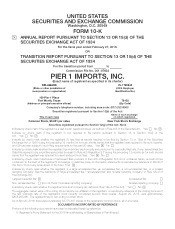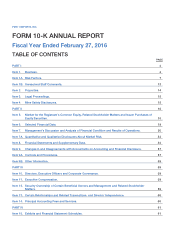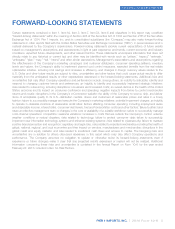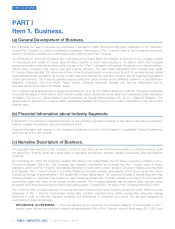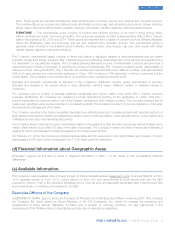Pier 1 2016 Annual Report Download - page 14
Download and view the complete annual report
Please find page 14 of the 2016 Pier 1 annual report below. You can navigate through the pages in the report by either clicking on the pages listed below, or by using the keyword search tool below to find specific information within the annual report.
ITEM 1A. RISK FACTORS.
An overall decline in the health of the economy in the United States or Canada and its
impact on consumer confidence and spending could negatively impact the Company’s
financial results.
The recessions experienced by the United States in various years adversely affected the discretionary spending, savings and
investments of consumers. The resulting deterioration in consumer confidence and spending during those recessionary periods
resulted in consumers reducing or eliminating their purchases of discretionary items, including the Company’s merchandise,
which negatively impacted the Company’s financial results during those years. Such recessions could occur again and could
have a significant impact on the Company’s financial results.
Failure to control merchandise returns could negatively impact the Company’s business
and financial results.
The Company has established a provision for estimated merchandise returns based upon historical experience and other known
factors. If actual returns are greater than those projected by management, additional reductions of revenue could be recorded in
the future. Also, to the extent that returned merchandise is damaged, the Company may not receive full retail value from the
resale of the returned merchandise. Introductions of new merchandise, changes in merchandise mix, associate selling behavior,
merchandise quality issues, changes to the Company’s return policy, e-Commerce return behavior, changes in consumer
confidence, new delivery channels/methods, recalls or other competitive and general economic conditions may cause actual
returns to exceed the provision for estimated merchandise returns. An increase in merchandise returns that exceeds the
Company’s current provisions could negatively impact the business and financial results.
A disruption in the operation of the domestic portion of the Company’s supply chain, or the
e-Commerce website, could impact the Company’s ability to deliver merchandise to its
stores and customers, which could impact its sales and results of operations.
The Company maintains regional distribution centers in Maryland, Ohio, Texas, California, Georgia and Washington. At these
distribution centers, merchandise is received, allocated, and shipped to the Company’s stores and customers, and at the
Company’s fulfillment centers in Ohio and Texas, e-Commerce orders are fulfilled. Major catastrophic events such as natural
disasters, fire or flooding, malfunction or disruption of the information systems, a disruption in communication services or power
outages, or shipping interruptions (including labor issues at the ports) could delay distribution of merchandise to the Company’s
stores and customers. Such disruptions could have a negative impact on the Company’s sales and results of operations.
Failure to successfully manage and execute the Company’s marketing initiatives could have
a negative impact on the Company’s business and results of operations.
The success and growth of the Company is dependent upon retaining existing customers and acquiring new customers to
generate increased traffic in order to produce sales in its stores and through the Company’s e-Commerce website. Successful
marketing efforts require the ability to obtain customer information and to reach customers through their desired mode of
communication utilizing various media outlets. Media placement decisions are generally made months in advance of the
scheduled release date. While gathering information about customers, the Company must consider the customers’ desire for
privacy and the need to comply with applicable laws and regulations. Any future changes in privacy laws or their interpretation or
enforcement by courts and governmental agencies could adversely impact our ability to market to customers. The Company’s
inability to obtain and use customer information, accurately predict and respect its customers’ preferences, utilize the desired
modes of communication, or ensure availability of advertised products may negatively impact the business and operating results.
Changes to estimates related to the Company’s property and equipment, or financial results
that are lower than its current estimates at certain store locations and determinations to
close underperforming stores, may cause the Company to incur impairment charges on
certain long-lived assets, negatively affecting its financial results.
The Company makes certain accounting estimates and projections with regard to individual store operations as well as overall
Company performance in connection with its impairment analyses for long-lived assets in accordance with applicable accounting
guidance. An impairment charge may be required if the impairment analysis indicates that the carrying value of an asset exceeds
the sum of the expected undiscounted cash flows of the asset. The projection of future cash flows used in this analysis requires
the use of judgment and a number of estimates and projections of future operating results. If actual results differ from the
Company’s estimates, additional charges for asset impairments may be required in the future. If impairment charges are
significant, the Company’s financial results could be negatively affected.
8PIER 1 IMPORTS, INC. 2016 Form 10-K





